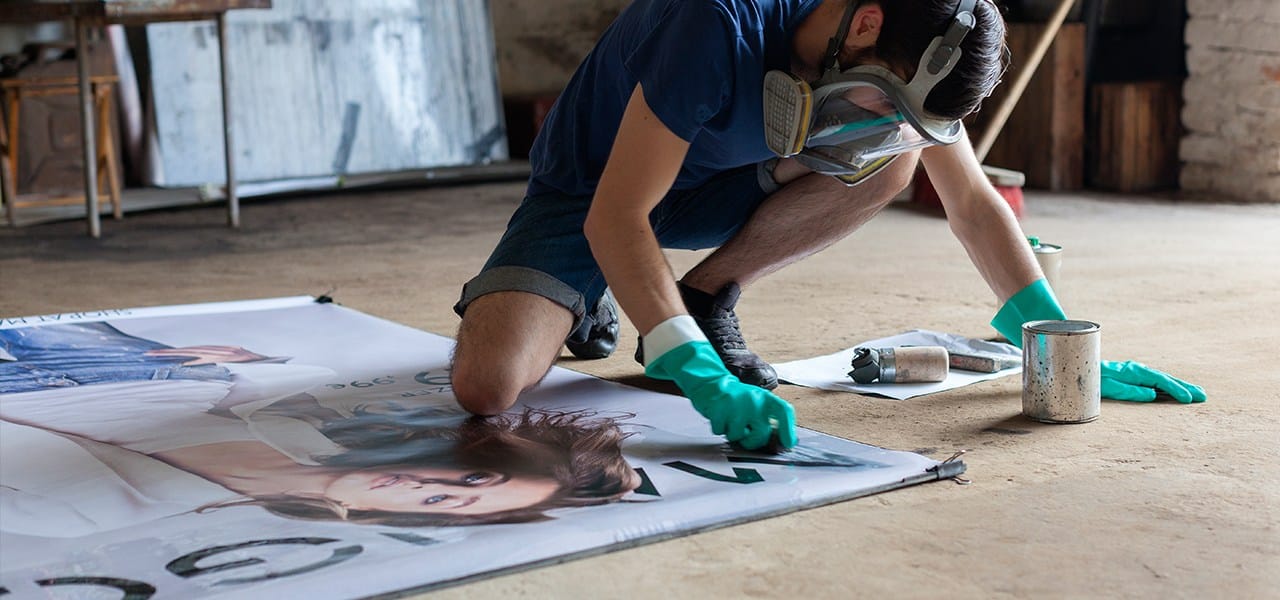
Vermibus – Unveiling Beauty, Studio work in Berlin, photo by Mark Rigney, courtesy of OPEN WALLS
Berlin, New York, Milan, Paris. If you’re living in any of these cities, chances are you’ve run into the works of Vermibus, probably wondering why the hell there’s a strange-looking advertisement in a given lightbox. They look awfully familiar, like those posters of models you see everywhere during Fashion Week and beyond, yet these are not exactly… pretty. Surely, they’re not what you’re used to. Indeed, the artist uses these advertisements as the basis for his work, as he modifies and re-installs them in order to question (mis)conceptions and impacts of beauty by Unveiling it, at the same time highlighting the role of advertising in serving us what we think we want to see, hear, experience and adopt as the ultimate standard.
But for Vermibus, it’s not just about the message – it’s about the medium and the place and the people it interacts with. His other celebrated project, titled NO-AD Project, was a personal voyage which aimed to create awareness of the space itself without assigning a new message or meaning to it. It consisted of removing any kind of advertising and leaving its former space empty, in a daring, liberating move. It was inspired by the Buy Nothing Day, founded by artist Ted Dave, who encouraged his participants not to buy anything for 24 hours. As a result, more than 30 posters were removed from one of the most consumer areas of Berlin.
Today, we can even talk about a NO-AD Day, celebrated every November 27, all thanks to a mysterious figure going by the moniker of Vermibus. Where does this creative, rebellious impulse to change the world one advertising poster at a time come from?
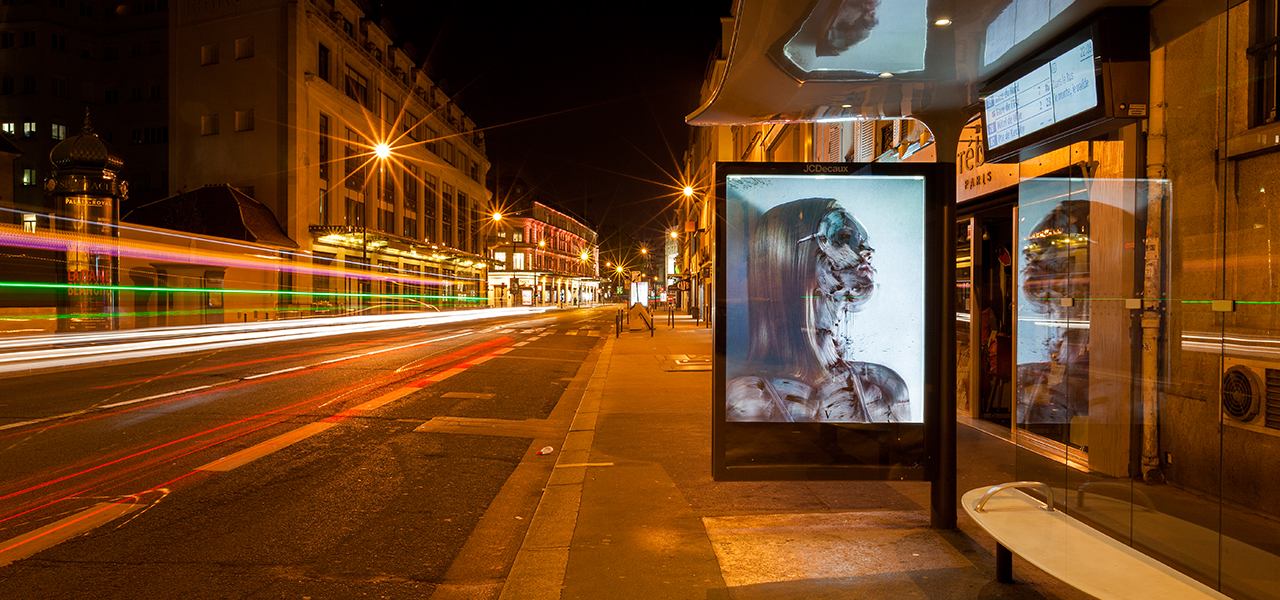
Vermibus – Unveiling Beauty, Paris, 2015 © Mark Rigney, Courtesy of the artist and OPEN WALLS Gallery
Beginnings and Evolution
OPEN WALLS: Can you tell us something about your beginnings as an artist? What motivated you to pursue artistic career? How and when did it all start?
Vermibus: I started painting graffiti in 1998 in Palma de Mallorca, where I come from. In that moment I had no idea what I was actually doing but made me feel good. In my neighborhood we were only a few people doing graffiti and at least for me, graffiti had no relation with the others, only with myself. When my mother realized that I was painting graffiti, she told me stories about one graffiti writer from her time in Madrid, Muelle, he was the pioneer of the graffiti in Spain, and he represented the “Flecheros” style. The graffiti in Spain was not introduced by the local hip hop culture, but by the Punks, and my really first tag was really influenced by punk culture, even if at that age I didn’t know what punk was.
We had a couple of walls of fame in Palma, and one of them, maybe the most relevant was “GESA”, a big wall of fame located halfway between my school and my house. Every morning we would pass by that wall and sometimes we would stop to see the pieces and take pictures of them. After some years, I moved from S’Arenal to the main city, Palma, and before we moved out from the old house I took a key from the gas counter thinking that maybe it would be useful for something, now knowing what that would be back then… But fifteen years later, I used it to open some of the light boxes from Berlin.
In 2003 I moved to Madrid. The difference between Mallorca and Madrid was overwhelming; in Mallorca there were only a few of us painting actively and being recognized was relatively easy, but not in Madrid. So, I stopped painting tags and I focused in painting drawings and characters for the next few years, trying out different media in a style that was not that common in Madrid, a style that was closer to what I understood as street art.
I always wanted to be an artist. For a few years, I was completely obsessed with being an advertiser, to the point where I was only buying magazines so I could remove the advertisings and categorize them in folders. I remember that one day when I met an advertiser at a party and asked him for advice. He recommended the book “99 Francs” from Frédéric Beigbeder, and it had a huge influence on the way I see this profession and made me see that the advertising industry was not my world. In those years I started hanging out with graffiti writers and their influence made me go back to wild style and focus only on what we understood as “real graffiti”, tags, scratching the glasses with a stone, acid… During that period, I started making my own inks, markers, spray cans and studying different stones, so I could penetrate the glass even deeper while scratching it, also using different solvents and acids.
I met Vota Dier, Ensamkeit, Neko and Noaz, all from the TGLQV? collective (Te Gusta Lo Que Ves? – Do you like what you see?). They were opening light boxes to install very political messages, and I went with them few times but I never asked them for a key because in that moment I didn’t think I had something to say. In 2009-2010, I started working for an advertising agency, first as an illustrator and later on as a photographer, covering events and parties. One important thing that I had to do was not only photograph all the people there, but to also delete the photos the “ugly people”, leaving only the beautiful ones in the event.
In the end of 2010 and early 2011, while we were having holidays, I decided to visit Berlin for 3 months while waiting for them to renew my contract. Two weeks before I was supposed to go back to Spain and restart my job, I got fired because they were looking for a full models team and I was not fitting in their aesthetics anymore. So, I decided not to take the flight back but to stay in Berlin indefinitely. There, I had the same sensation that I had years before when I moved to Madrid. Berlin was full of graffiti and street art and I had to find a new spot and a new way of making my place in a new city. In a very natural way I started opening light boxes to install my work.
OPEN WALLS: Can you describe the evolution of your style over the years? Are there any important phases in your career you would like to highlight? How did your technique evolve during the years?
Vermibus: After five years of moving from studio to studio, I found out that each of them had different ambients that made me paint in a different way. The first studio was in a basement in 2011 and this space inspired me to paint in a particular style that I’m keeping since then. I made kind of a replica of this studio in the “Unmasking Kate” exhibition. Between 2012 and 2015, after I moved to Stattbad Wedding, my technique and the style evolved again. I was more conscious of every stroke, trying to put in harmony the emotion and the technique. In the last two years, there was a studio in a “glasshouse”, located in a tractors’ parking. I was surrounded by nature and I guess that influenced my work a lot and I started to add colors to the artworks and that is what I’m developing at the moment in my current studio.

Vermibus, Unveiling Beauty, New York, 2015 © Mark Rigney, Courtesy of the artist and OPEN WALLS Gallery
The Creative Process
OPEN WALLS: What are those specific features that make your work unique and original?
Vermibus: I guess is a mix between different things, the fact that I’m using and investigating materials that nobody else is using neither in the street nor in fine arts. Working with a message that is on a lot of people’s minds already and placing it in a place that is not common. And also trying to communicate my opinion and work in a clean and professional way. That’s what I think, but I don’t really know.
OPEN WALLS: What does your creative process look like?
Vermibus: My process of work has a lot of steps, maybe the most visible is the painting process, but as important as that is, there’s also the research and accumulation of posters, fashion books, as well as producing the keys to open the light boxes… When it comes to painting, my only goal is flowing – I try to concentrate not on the technique or the result but the direction that the artwork is taking and how I feel with it. I work without sketches and without any idea of how I want the artwork to look like once is finished. Every image has a particular moment, I’ve been saving images for years waiting for the right moment to work on them. Music is also of big importance in my working process, if it’s not in concordance of my feelings, I cannot work and the result will not be good.
OPEN WALLS: Which project, exhibition artwork etc do you find most significant in your work so far? Can you single out some important milestones in your career?
Vermibus: Milestones:
– 2011 first intervention & Vermibus Process.
– 2012 NO-AD project & Unmasking Kate
– 2013 Dissolving Europe
– 2014 NO-AD Day
– 2015 Unveiling Beauty
– 2016 Speech in La Casa Encendida. It was first time I showed my face in public and I got in touch with the restorers, trying to find a way to preserve my works.
– Solvent on Paper
– Solvent with brush.
– Different solvents.
– Modifying the brushes.
– Adding colors
– Restoration and conservation studies.

Vermibus, Unveiling Beauty, Milan, 2015 © Mark Rigney, Courtesy of the Artist and Open Walls Gallery
Unveiling Beauty – The Power of Advertising
OPEN WALLS: What are the themes you usually tackle in your work and why are they of particular interest to you?
Vermibus: The main topic that I develop is the reflection of our way of understanding the concept of beauty. The theme of every artwork is different and it sometimes varies from the moment I start working on it to the one I see the final version and I put a title to it. Normally, the titles have a common line; the moments of happiness and unhappiness that we all share, depression and its overcoming, love and heartbreak, the traumas from the past, the fears from the future… everything that makes us emotionally and human. In my artworks I’m not only trying to show the fragility of people behind the campaigns, but to also my own fragility in the skin of others.
OPEN WALLS: What are the messages you’re trying to send to the viewers and what are the responses (feelings, questions, thoughts…) you hope to provoke?
Vermibus: In the activist part, what I want is to create awareness about public space advertising. By opening those spaces, I make them vulnerable and I create a conversation not only with the brands or the companies that put advertising in the public space but also with the citizen, breaking the unidirectional message. Awareness is a very important and personal part of every artwork. Like I said before, in my artworks I don’t only show the fragility of the people who are behind every campaign, but my own fragility as well.
OPEN WALLS: Having said all this, how big is the influence on advertising on our lives, in your opinion? Can we change the way it affects us?
Vermibus: Advertising is affecting us on every single level; personal, sociological, political and environmental. It also affects our mental health, the chemical system of our body, customs, decision-making, freedom of the press, freedom of speech… When I say that advertising is affecting every single level of our life I really mean it. We are facing new dangers. On one hand, the new technologies at the service of the advertising, like Big Data, that is using every single information that we are publishing about us, checking every single movement that we make, on the internet and in the public space, with satellites and on the other hand the Neuromarketing, which is studying how our brain works in order to make the advertisings more effective in a scientific way.
The adverts might be legitimate if the viewer decides consciously to see them. But in order to have a conscious decision about that, we need to be aware of their dangers and for that we should be informed in the first place. For example: if you are an adult, you are free to smoke or not, but you should know the risk you are taking and the consequences before starting to smoke. You cannot smoke in certain places, children cannot buy cigarettes, and most importantly, you cannot force anyone to smoke. With advertising it is the same: it is addictive, affects mentally and chemically our body, our decisions, the environment… it has a huge risk on all the levels that we are ignoring.

Vermibus, Unveiling Beauty, London, 2015 © Mark Rigney, Courtesy of the artist and OPEN WALLS Gallery
Vermibus on Influences and Inspiration
OPEN WALLS: Who are your biggest influences; people, movements, styles you looked upon while establishing your visual language?
Vermibus: Classical painters like Francisco de Goya, Francis Bacon, Lucien Freud, Joaquín Sorolla, Edvard Munch… In every moment of my life I have different kind of influences. Mostly I try to study painters, how they developed their style, colors, thematics… but I’ve also been influenced by movie directors, illustrators, photographers, activists and I guess also fashion and advertising.
OPEN WALLS: What is your greatest inspiration?
Vermibus: Happiness, love and their opposites.
OPEN WALLS: What are your goals and plans for the future?
Vermibus: Keep working. In early June I will have a Solo Show at OPEN WALLS Gallery (Berlin) where I will show my latest artworks. In mid-June I will show some of my artworks in The Poster Remediated anniversary exhibition of the 25th International Poster Biennale in Warsaw.

Vermibus, Ceniza Y Sed, Solvent on Original Advertising Poster, 120 x 170cm, 2015 – © OPEN WALLS Gallery 2015, Courtesy Private Collection – Paris
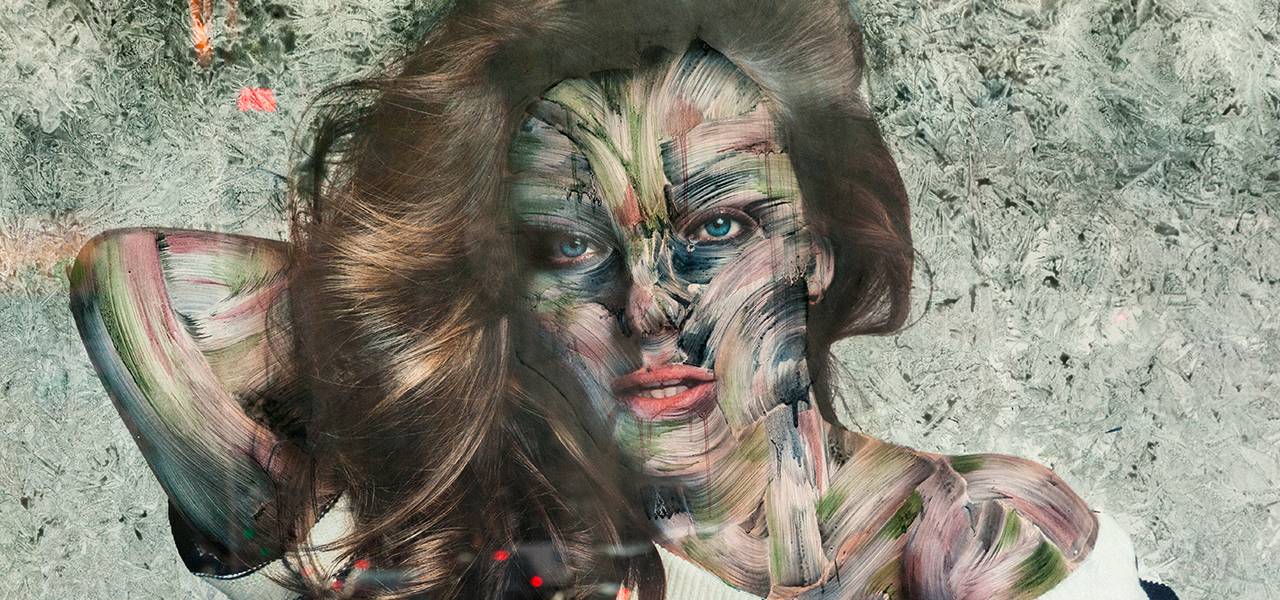
Vermibus – Unveiling Beauty, Paris, 2015 © Mark Rigney, Courtesy of the artist and OPEN WALLS Gallery
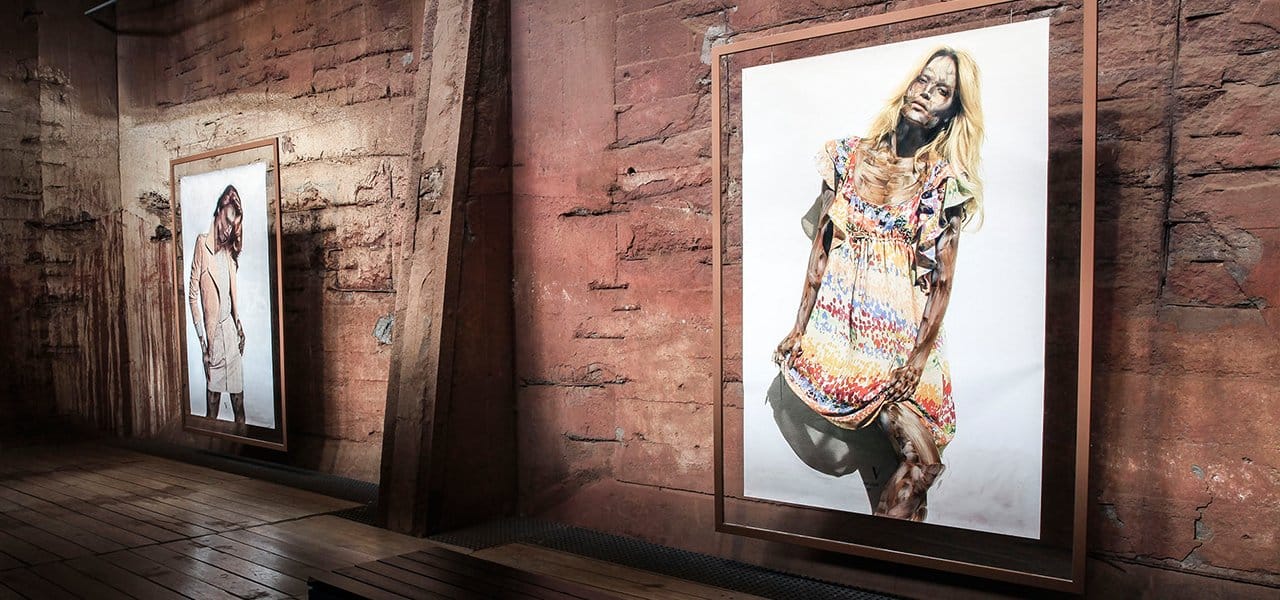
Vermibus, via his website
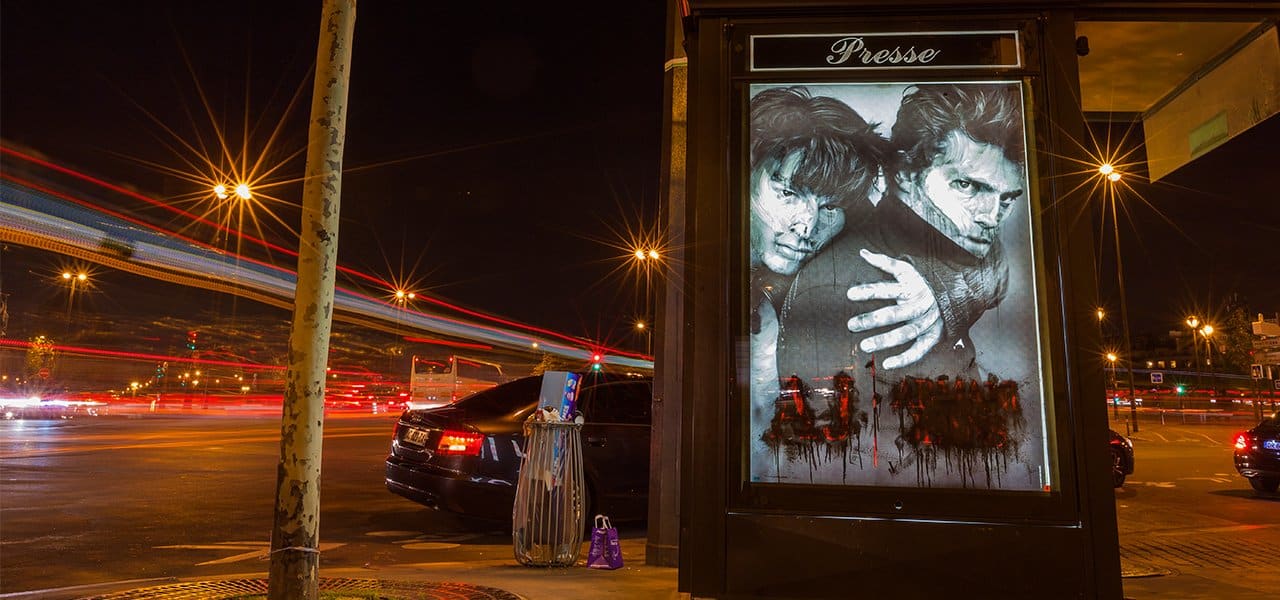
Vermibus – Unveiling Beauty, Paris, 2015 © Mark Rigney, Courtesy of the artist and OPEN WALLS Gallery